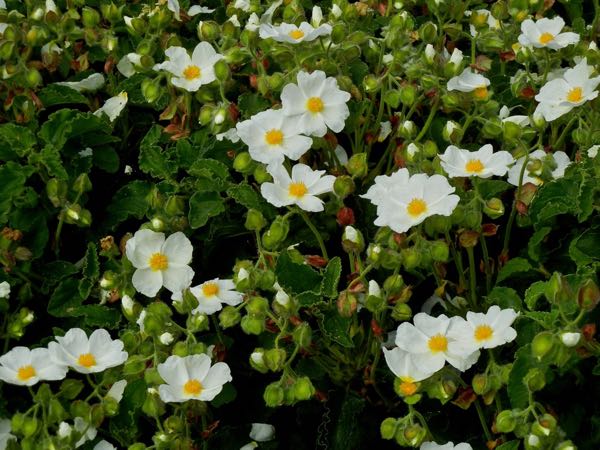Cistus salviifolius: The Sage-leaved Rock-rose
Cistus salviifolius, commonly known as the Sage-leaved Rock-rose, is a captivating member of the Cistaceae family of plants. This low-growing shrub is celebrated for its ability to create a stunning ground cover with its charming characteristics and adaptability. It is also referred to by other names such as Salvia cistus, Gallipoli Rose, or simply Cistus.
Family and Names: Belonging to the Cistaceae family, Cistus salviifolius shares its lineage with other notable plants like Cistus ladanifer and Cistus albidus. The name “Cistus” has its origins in Ancient Greek, derived from the word “kistē,” meaning basket. This name refers to the basket-like appearance of the flowers in some species of the Cistus genus. The specific epithet “salviifolius” is a combination of the Latin words “salvia” (meaning sage) and “folius” (meaning leaves), alluding to the wrinkled or sage-like leaves of this particular species.
Characteristics: Cistus salviifolius displays an array of distinct characteristics that contribute to its ornamental appeal. The stems of this shrub are covered in fine hairs, lending it a soft and slightly textured appearance. It typically reaches a height of about 2 feet (60 cm) and can spread up to 6 feet (1.8 m), forming an attractive low-growing mound. The oval-shaped leaves are arranged oppositely along the stems and feature a striking greyish-green hue, adding a subtle elegance to the plant’s overall aesthetic.
Flowering Season: One of the most enchanting features of Cistus salviifolius is its profusion of delicate flowers, which bloom during the months of April and May, heralding the arrival of spring. The flowers emerge from the leaf axils, showcasing their beauty against the backdrop of the greyish-green foliage. Measuring approximately 1.5 inches (3.5 cm) in width, these blossoms exhibit a classic five-petal structure, with a white coloration and a distinctive yellow spot at the base of each petal. The stamens, prominent in their bright yellow hue, provide an eye-catching contrast against the petals. This captivating floral display not only adds visual appeal but also serves as a valuable food source, attracting pollinators such as bees and various insects.
Cultivation of Cistus salviifolius:
Growing Cistus salviifolius is a rewarding experience, thanks to its hardy nature and adaptability. Here are some cultivation tips to ensure the successful growth and maintenance of this remarkable plant:
Sunlight Requirements: Cistus salviifolius thrives in full sun conditions. It is best to provide it with at least six to eight hours of direct sunlight daily to promote healthy growth and abundant flowering.
Soil Conditions: This shrub prefers well-drained soil that is not overly rich in organic matter. It can tolerate a variety of soil types, including sandy or rocky soils. However, it is crucial to ensure adequate drainage to prevent waterlogging, which can be detrimental to the plant’s health.
Watering Needs: Once established, Cistus salviifolius exhibits excellent drought tolerance, making it an ideal choice for water-wise gardens. While it can withstand dry conditions, it is essential to water the plant regularly during its establishment phase or during prolonged periods of extreme heat. Water deeply and allow the soil to dry out between waterings to avoid overwatering.
Suitable Environments: Cistus salviifolius is well-suited to various environments and can thrive in different climatic conditions. It is particularly favored in Mediterranean and coastal regions where it can withstand the challenging combination of high temperatures, limited rainfall, and well-drained sandy or rocky soils. This adaptability to coastal conditions makes it an excellent choice for seaside gardens or landscapes with salty air.
Deer Resistance: The strong aromatic foliage of Cistus salviifolius acts as a natural deterrent to deer and other browsing animals. This makes it an excellent choice for gardens located in areas with deer populations, as it is less likely to be damaged or consumed by these animals.
Maintenance and Pruning: Cistus salviifolius is a relatively low-maintenance plant. It generally requires minimal pruning, with the exception of occasional removal of dead or damaged branches to maintain its neat appearance. Light pruning immediately after flowering can help shape the plant and encourage a more compact growth habit.
Pests and Diseases: Cistus salviifolius is generally resistant to pests and diseases. However, like any plant, it may occasionally face issues such as aphid infestations or fungal diseases. Regular inspection of the foliage and prompt action, if necessary, can help prevent the spread of pests or diseases. Additionally, providing adequate spacing between plants and ensuring good air circulation can minimize the risk of fungal infections.
Propagation: Cistus salviifolius can be propagated through seeds or softwood cuttings. Collect mature seeds from the plant once the seed capsules have dried and started to split open. Sow the seeds in well-draining soil, keeping them slightly moist until germination occurs. Softwood cuttings taken in late spring or early summer can also be rooted in a suitable propagation medium, providing a reliable method to propagate new plants.

Conclusion: With its captivating beauty, adaptability, and low-maintenance nature, Cistus salviifolius, the Sage-leaved Rock-rose, is an excellent choice for adding charm to gardens, rockeries, or sunny borders. Whether utilized as a ground cover or incorporated into mixed planting schemes, its greyish-green foliage and delicate white flowers with yellow accents are sure to captivate both gardeners and pollinators alike. By providing the plant with well-drained soil, ample sunlight, and appropriate watering, you can enjoy the beauty of Cistus salviifolius while creating a resilient and enchanting garden space.
Also, read about Cistus x purpureus or Rock Rose



